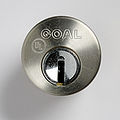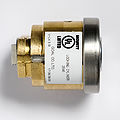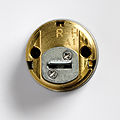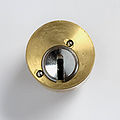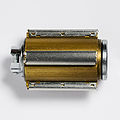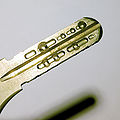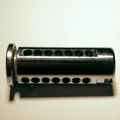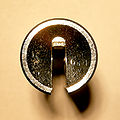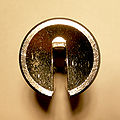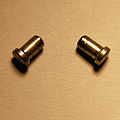Goal V18
GOAL V18
| GOAL V18 | |
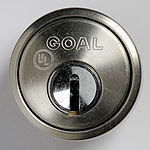 | |
| Name | GOAL V18 |
|---|---|
| Manufacturer | GOAL |
| Lock Type | cylinder |
| Lock Design | Pin-tumbler, Dimple |
| Specifications | |
| # of Components | 21 |
| Component Type | Pin-tumbler |
| Related Locks | |
| GOAL D9 | |
The V18 is a dimple lock made by GOAL. Drilled for 21 pins, it contains up to 19 active pins and two core-centering pins. Pins are arranged in rows of seven on the left, top, and right of the keyway.
Principles of operation
The GOAL V18 utilizes dimple keys but functions the same as a standard pin-tumbler lock. The dimple key of the V18 has four cut depths for side pins and three, different cut depths for top pins. The design offers 12 billion key differences when pinned with 18 active pins. The key is bitted on the sides and edges of the blade and is reversible. To open the lock, all active pin-tumblers -- across all three rows of pins -- must be aligned at the shear line.
GOAL utilizes a variety of security pins to deter picking, the V18 uses a mix of thin and thick lipped mushroom spool drivers. Key pins are most often a combination of t-pins and tapered spools which are torpedo shaped to create overset traps. Additionally, the plug features overmilling to catch pins as they are lifted to shear. See also Pin-tumbler (Principles of Operation)
Model variations
The V18 is sold in two primary form factors:
- A compact cylinder used in Goal's AD-series dead locks (housing V-TX)
- A rim cylinder for standard applications (model V-LX 5)
Both utilize the same components and general security features. The rim cylinder is larger, more robust, and incorporates steel ball bearings for drill protection. The compact cylinder features easy-to-remove bible covers and hence is much easier to re-pin.
The V18 system is available in a UL 437 rated cylinder.
Gallery
Key & cylinder of the V18 with that of a GOAL D9.
See also
| This article is a stub. You can help Lockwiki by expanding it. |

